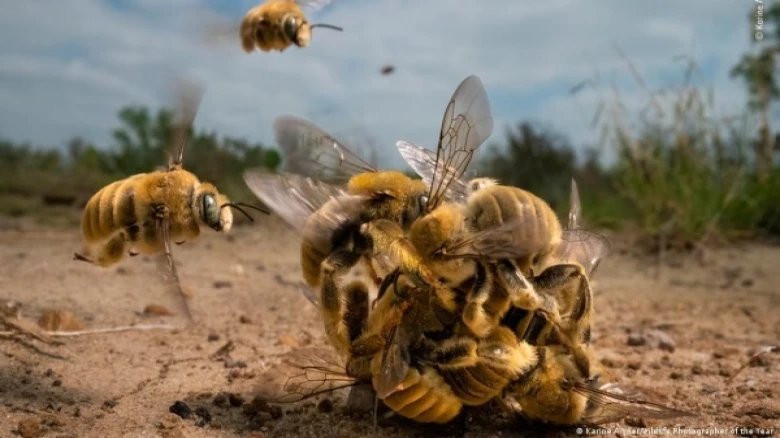The winners of the Wildlife Photographer of the Year and Young Wildlife Photographer prizes have been revealed by the Natural History Museum in London. Here are some of the better images.
Digital Desk: The winners of the Natural History Museum's annual Wildlife Photographer of the Year competition have been announced, and their work will be on display at the museum from October 14 to July 2, 2023.
Karine Aigner of the United States won this year's top prize with an image showing numerous bees balled up together with a couple of others flying around.
The shot, titled "The Big Buzz," was taken on a Texas ranch. The bees were concentrated on mating with a single female at the centre, according to a news release from the prize organisers. Climate change and habitat degradation, as well as farming practises that interrupt their nesting grounds, are all threats to these cactus bees, according to the statement.
Karin Aigner is the competition's fifth female winner of the top prize in the adult category.
Katanyou Wuttichaitanakorn, a 16-year-old Thai photographer, was named Young Wildlife Photographer of the Year 2022 for his interesting photograph of a Bryde's whale's open jaw.
The contrast between the whale's dark skin, pink gum, and the brush-like mass of baleen hanging from its top jaw is highlighted in the photograph. Baleen are filter-feeding systems found inside baleen whales' mouths. The image is titled "The Beauty of Baleen."
Fernando Constantino Martnez Belmar captured "The bat-snatcher" with a red light, which both bats and snakes are less sensitive to.
Belmar kept his gaze fixed on the Yucatan rat snake protruding from a crevice. The rat snake pounced, seizing a bat out of mid-air before withdrawing into its crevice with its victim, according to the Natural History Museum's website.
"What made the photograph for me is the timing — the quickness and alertness of the snake, the bat with its mouth left open, and both predator and prey half-hung in air," said Sugandhi Gadadhar, a wildlife videographer.
Junji Takasago took this shot, titled "Heavenly Flamingos." Takasago overcame altitude sickness to photograph the scene high in the Andes.
The world's largest salt pan, Salar de Uyuni, is located in southwest Bolivia and is renowned as the "mirror in the sky." These bizarre salt flats are the remnants of a vast lake that has long since dried up.
According to the Natural History Museum, the salt pan is also home to one of Bolivia's major lithium mines, which is endangering the area's flamingos.
South African Brent Stirton took this photograph of a famous mountain gorilla named Ndakasi in the Democratic Republic of the Congo.
The judges reviewed across over 38,500 submissions from 93 countries. The Natural History Museum is also releasing a book featuring 150 images from this year's competition that won in several categories.
The pictures will be shown in Switzerland, Australia, Canada, the United States, France, Germany, and New Zealand, among other places.
"Wildlife photographers offer us remarkable glimpses into the lives of wild species, exposing overlooked details, fascinating behaviours, and frontline reporting on the climate and biodiversity problems," said Doug Gurr, director of the Natural History Museum, of the annual event. These photographs illustrate their astonishment and admiration for the natural environment, as well as the urgent need to safeguard it."










Leave A Comment